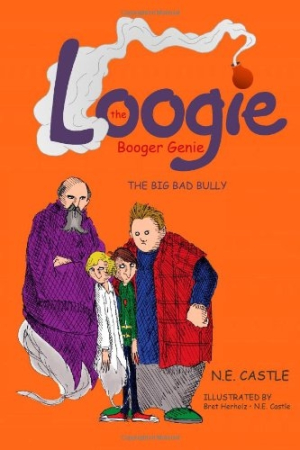Loogie the Booger Genie
The Big Bad Bully
Middle-grade fantasy hits the sweet spot halfway between the magic of Harry Potter and the juvenile humor of Captain Underpants.
Bullies are a part of growing up, even for kids with genies. In Loogie the Booger Genie: The Big Bad Bully, N. E. Castle tells the story of Charlie, Tom, Loogie, and the rest of the the Booger Genie gang as they deal with Bobby Johnson, a bully who targets Charlie and his friends, in this third volume in the series.
There’s more to the story than just bully Bobby Johnson. Castle continues to develop the character of Tildor, a genie whom Loogar (Loogie’s full name) knows as a bully in his own right. Charlie, the young boy who carries Loogar’s tiny home in a pendant around his neck, tries to utilize Loogar’s wish-granting powers responsibly, but Charlie’s friend Tom grows jealous, wishing he had his own genie to grant wishes.
The narrative delivers several lessons—about bullying, jealousy, and true friends versus those who would pose as friends—while avoiding overt preachiness. Readers get to see the consequences of decisions made by the characters, not just hear about them.
Castle’s story hits a sweet spot halfway between the mystery and magic of the Harry Potter series and the silly humor of Dav Pilkey’s Captain Underpants books. For example, there’s a funny (and very modern) moment when Tom asks for an iPad and Tildor, the troublesome genie whom Tom thinks he controls, produces a pirate-style eye patch.
The black-and-white illustrations are woven into the text, and their reduced size makes them a perfect bridge for children working up from full-page picture books to text-only books.
The rich backstory includes previously introduced characters like Hendrick the wizard and Miss Bellediddy, Loogar’s onetime nanny, and will be of particular interest to those who’ve read the other two installments in the series. New readers may find it all a bit confusing because Castle has her characters summarize events in passages like this: “Tildor destroys all that is good. He destroyed the friendship between Pawklin Castle and Garoth. At one time my father and King Ragnot were great friends. That was before Tildor joined the ranks of Pawklin. He turned King Ragnot against my father.”
More times than not, Castle uses dialogue to tell the story, which keeps things moving at a brisk pace. That said, a character guide or something similar at the beginning of the book might help readers focus more on what’s happening and less on figuring out how everyone is connected.
Loogie the Booger Genie: The Big Bad Bully is a fun read and a step in the right direction; as Castle’s characters endure trials and tribulations, they grow in complexity. Perhaps Castle is leading up to some fireworks as she continues to lay the path for (one would think) an eventual confrontation between Loogar and Tildor.
Reviewed by
Peter Dabbene
Disclosure: This article is not an endorsement, but a review. The publisher of this book provided free copies of the book and paid a small fee to have their book reviewed by a professional reviewer. Foreword Reviews and Clarion Reviews make no guarantee that the publisher will receive a positive review. Foreword Magazine, Inc. is disclosing this in accordance with the Federal Trade Commission’s 16 CFR, Part 255.

